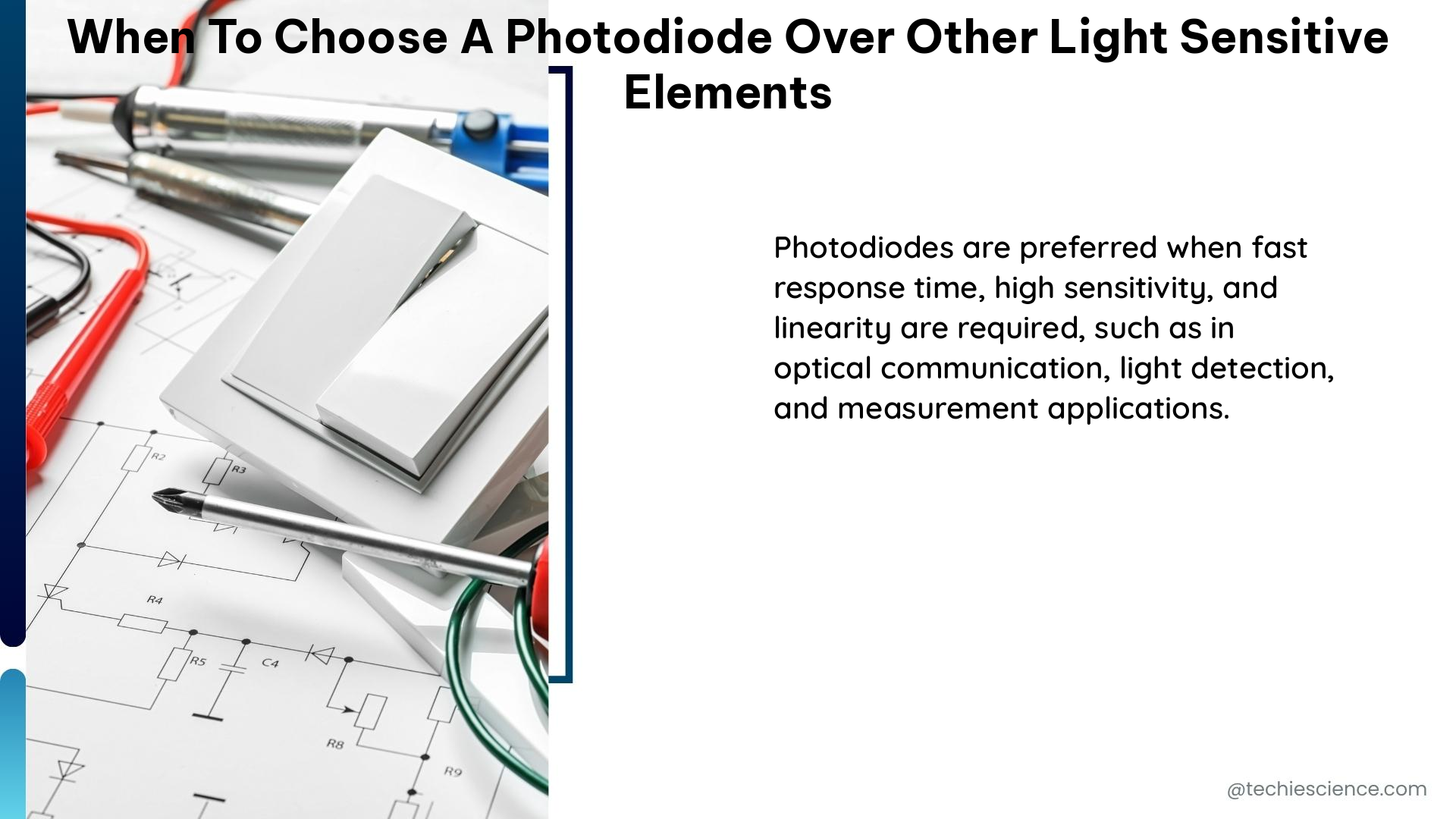When choosing a photodiode over other light-sensitive elements, there are several measurable and quantifiable factors to consider, including sensitivity, spectral response, response time, linearity, and cost. Photodiodes offer distinct advantages in many applications due to their superior performance characteristics.
Sensitivity
Photodiodes have a higher sensitivity compared to other light-sensitive elements, such as phototransistors. The sensitivity of a photodiode is typically measured in Amperes per Watt (A/W) and indicates how well the device can convert light into electrical current. Standard p-i-n photodiodes can achieve a maximum sensitivity of around 0.55 A/W, while advanced photodiodes can reach sensitivities up to 0.95 A/W.
The high sensitivity of photodiodes is due to their ability to generate one electron-hole pair per absorbed photon, without any internal gain. In contrast, phototransistors rely on current amplification, which can result in lower sensitivity and higher noise levels. The sensitivity of photodiodes is also largely independent of the applied reverse bias voltage, making them more stable and reliable in various applications.
Spectral Response

Photodiodes have a broad spectral response, making them suitable for a wide range of applications. The spectral response of a photodiode is determined by the material it is made of. Silicon (Si) photodiodes are sensitive to visible and near-infrared (NIR) light, with a typical spectral range of 400 to 1100 nanometers (nm). Indium gallium arsenide (InGaAs) photodiodes, on the other hand, are sensitive to near-infrared and short-wave infrared (SWIR) light, with a spectral range of 800 to 1700 nm.
The ability to choose a photodiode with the appropriate spectral response is crucial in applications such as optical communications, spectroscopy, and machine vision. For example, Si photodiodes are commonly used in visible light applications, while InGaAs photodiodes are preferred for NIR and SWIR applications, where the target wavelengths are outside the sensitivity range of Si.
Response Time
Photodiodes have a faster response time compared to other light-sensitive elements, such as phototransistors. The response time of a photodiode is typically measured in nanoseconds (ns) and indicates how quickly the device can respond to changes in light intensity.
Silicon photodiodes can have a response time as fast as 1 ns, making them suitable for high-speed applications like optical communication systems, laser rangefinders, and time-of-flight (ToF) cameras. In comparison, phototransistors typically have a response time in the range of microseconds (μs) to milliseconds (ms), which is much slower.
The fast response time of photodiodes is due to their simple structure and the absence of internal current amplification, which can introduce additional delays. This makes photodiodes the preferred choice for applications that require high-speed light detection and signal processing.
Linearity
Photodiodes have a high degree of linearity, meaning that the output current is directly proportional to the input light intensity. This linear relationship is maintained over a wide dynamic range, typically spanning several orders of magnitude.
The linearity of a photodiode is typically expressed as the deviation from an ideal linear response, often measured in terms of a percentage. High-quality photodiodes can achieve linearity of better than 1% over their entire dynamic range, making them suitable for applications where accurate light intensity measurements are required, such as in scientific instrumentation, industrial automation, and medical imaging.
In contrast, other light-sensitive elements, like phototransistors, may exhibit non-linear behavior, especially at high light levels, which can introduce errors and complicate the interpretation of the sensor’s output.
Cost
Photodiodes are generally more expensive than other light-sensitive elements, such as phototransistors. However, their higher sensitivity, faster response time, and higher linearity make them a cost-effective solution for many applications.
The cost of a photodiode can vary depending on factors like the material it is made of, its sensitivity, and its response time. For example, silicon photodiodes are typically less expensive than indium gallium arsenide (InGaAs) photodiodes, which are used for near-infrared and short-wave infrared applications.
Despite the higher initial cost, the superior performance characteristics of photodiodes can often justify their use in applications where accuracy, speed, and reliability are critical. The long-term cost savings and improved system performance can outweigh the higher upfront cost of a photodiode.
In summary, when choosing a photodiode over other light-sensitive elements, it is essential to carefully evaluate factors such as sensitivity, spectral response, response time, linearity, and cost to select the most appropriate device for the specific application requirements.
References
- Analog Devices Inc., “Photodiodes and other Light Sensors,” Analog Devices Wiki, 2014-08-09. [Online]. Available: https://wiki.analog.com/university/courses/electronics/text/light-sensors-photodiodes
- Cadence Design Systems, “Photodiode Array vs. CCD: Which Is Best for Your Optical System?,” Cadence Blog, 2020-01-09. [Online]. Available: https://resources.pcb.cadence.com/blog/2020-photodiode-array-vs-ccd-which-is-best-for-your-optical-system
- Electronics Stack Exchange, “How to tell how sensitive a photodiode is?,” Electronics Stack Exchange, 2018-12-11. [Online]. Available: https://electronics.stackexchange.com/questions/411679/how-to-tell-how-sensitive-a-photodiode-is

The lambdageeks.com Core SME Team is a group of experienced subject matter experts from diverse scientific and technical fields including Physics, Chemistry, Technology,Electronics & Electrical Engineering, Automotive, Mechanical Engineering. Our team collaborates to create high-quality, well-researched articles on a wide range of science and technology topics for the lambdageeks.com website.
All Our Senior SME are having more than 7 Years of experience in the respective fields . They are either Working Industry Professionals or assocaited With different Universities. Refer Our Authors Page to get to know About our Core SMEs.